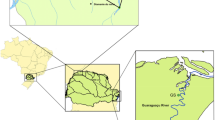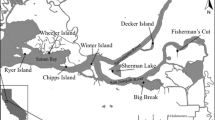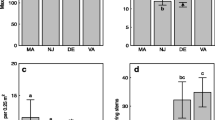Abstract
Through their physiological effects on ion, oxygen, and carbon balance, respectively, salinity, sulfide, and prolonged flooding combine to constrain the invasion and spread ofPhragmites in tidal wetlands. Initial sites of vigorous invasion by seed germination and growth from rhizome fragments appear limited to sections of marsh where salinity is <10‰, sulfide concentrations are less than 0.1 mM, and flooding frequency is less than 10%. In polyhaline tidal wetlands the invasion sites include the upland fringe and some high marsh creek banks. The zones of potential invasion tend to be larger in marshes occupying lower-salinity portions of estuaries and in marshes that have been altered hydrologically. Owing to clonal integration and a positive feedback loop of growth-induced modification of edaphic soil conditions, however, a greater total area of wetland is susceptible toPhragmites expansion away from sites of establishment. Mature clones have been reported growing in different marshes with salinity up to 45‰, sulfide concentration up to 1.75 mM, and flooding frequency up to 100%. ForPhragmites establishment and expansion in tidal marshes, windows of opportunity open with microtopographic enhancement of subsurface drainage patterns, marsh-wide depression of flooding and salinity regimes, and variation in sea level driven by global warming and lunar nodal cycles. To avoidPhragmites monocultures, tidal wetland creation, restoration, and management must be considered within the context of these different scales of plant-environment interaction.
Similar content being viewed by others
Literature Cited
Adams, J. andG. Bate. 1999. Growth and photosynthetic performance ofPhragmites australis in estuarine waters: A field and experimental approach.Aquatic Botany 64:359–367.
Amsberry, L., M. A. Baker, P. J. Ewanchuk, andM. D. Bertness. 2000. Clonal integration and the expansion ofPhragmites australis.Ecological Applications 10:1110–1118.
Armstrong, J., F. Afreen-Zobayed, andW. Armstrong. 1996.Phragmites die-back: Sulphide- and acetic acid-induced bud and root death, lignifications, and blockages within aeration and vascular systems.New Phytologist 134:601–614.
Armstrong, J., F. Afreen-Zobayed, S. Blyth, andW. Armstrong. 1999.Phragmites australis: Effects of shoot submergence on seedling growth and survival and radial oxygen loss from roots.Aquatic Botany 64:275–289.
Armstrong, J. andW. Armstrong. 1991. A convective through-flow of gases inPhragmites australis (Cav.) Trin. ex Steudel.Aquatic Botany 39:75–88.
Armstrong, J., W. Armstrong, andP. M. Beckett. 1992.Phragmites australis: Venturi- and humidity-induced pressure flows enhance rhizone aeration and rhizosphere oxidation.New Phytologist 120:197–207.
Baldwin, A. H. andI. A. Mendelssohn. 1998. Effects of salinity and water level on coastal marshes: An experimental test of disturbance as a catalyst for vegetation change.Aquatic Botany 61:255–268.
Bart, D. J. andJ. M. Hartman. 2000. Environmental determinants ofPhragmites australis expansion in a New Jersey salt marsh: An experimental approach.Oikos 89:59–69.
Bart, D. J. andJ. M. Hartman. 2002. Environmental constraints on early establishment ofPhragmites australis in salt marshes.Wetlands 22:201–213.
Bart, D. andJ. M. Hartman. 2003. The role of large rhizome dispersal and low salinity windows in the establishment of common reed,Phragmites australis in salt marshes: New links to human activities.Estuaries 26:436–443.
Burdick, D. M., R. Buchsbaum, andE. Holt. 2001. Variation in soil salinity associated with expansion ofPhragmites australis in salt marshes.Environmental and Experimental Botany 46:247–261.
Burdick, D. M. andM. Dionne. 1994. Comparison of salt marsh restoration and creation techniques in promoting native vegetation and functional values. Office of State Planning, Concord, New Hampshire.
Burdick, D. M., M. Dionne, R. M. Boumans, andF. T. Short. 1997. Ecological responses to tidal restoration of two northern New England salt marshes.Wetlands Ecology and Management 4:129–144.
Chambers, R. M., L. A. Meyerson, andK. Saltonstall. 1999. Expansion ofPhragmites into tidal wetlands of North America.Aquatic Botany 64:261–273.
Chambers, R. M., T. J. Mozdzer, andJ. C. Ambrose. 1998. Effects of salinity and sulfide on the distribution ofPhragmites australis andSpartina alterniflora in a tidal saltmarsh.Aquatic Botany 62:161–169.
Chambers, R. M., D. T. Osgood, andN. Kalapasev. 2002. Hydrologic and chemical control ofPhragmites growth in tidal marshes of SW Connecticut, USA.Marine Ecology Progress Series 239:83–91.
Clevering, O. andJ. Lissner. 1999. Taxonomy, chromosome numbers, clonal diversity and population dynamics ofPhragmites australis.Aquatic Botany 64:185–208.
Crawford, R. M. M. andR. Braendle. 1996. Oxygen deprivation stress in a changing clinate.Journal of Experimental Botany 47:145–159.
Dahl, T. E. andC. E. Johnson. 1991. Status and trends of wetlands in the conterminous United States, mid-1970s to mid-1980s. U.S. Fish and Wildlife Service, Washington, D.C.
Emery, N. C., P. J. Ewanchuk, andM. D. Bertness. 2001. Competition and salt marsh zonation: Stress tolerators may be dominant competitors.Ecology 82:2471–2485.
Furtig, K., A. Ruegsegger, C. Brunold, andR. Brandle. 1996. Sulphide utilization and injuries in hypoxic roots and rhizomes in common reed (Phragmites australis).Folia Geobotany Phytotaxonomy 31:143–151.
Gries, C., L. Kappen, andR. Losch. 1990. Mechanism of flood tolerance in reed,Phragmites australis (Cav.) Trin. ex Steudel.New Phytologist 114:589–593.
Hanganu, J., G. Mihaila, andH. Coops. 1999. Responses of ecotypes ofPhragmites australis to increased seawater influence: A field study in the Danube Delta, Romania.Aquatic Botany 64:351–358.
Hartzendorf, T. andH. Rolletschek. 2001. Effects of NaCl-salinity on amino acid and carbohydrate contents ofPhragmites australis.Aquatic Botany 69:195–208.
Havens, K. J., W. I. Priest, III, andH. Berquist. 1997. The investigation ofPhragmites australis within Virginia's constructed wetland sites.Environmental Management 21:599–605.
Hellings, S. andJ. L. Gallagher. 1992. The effects of salinity and flooding onPhragmites australis.Journal of Applied Ecology 29:41–49.
Hootsmans, M. J. M. andF. Wiegman. 1998. Four helophyte species growing under salt stress: Their salt of life?Aquatic Botany 62:81–94.
Howes, B. L., J. W. H. Dacey, andD. D. Goehringer. 1986. Factors controlling the growth form ofSpartina alterniflora: Feedbacks between above-ground production, sediment oxidation, nitrogen and salinity.Journal of Ecology 74:881–898.
Koch, M. S., I. A. Mendelssohn, andK. L. McKee. 1990. Mechanism for the hydrogen sulfide-induced growth limitation in wetland macrophytes.Limnology and Oceanography 35:399–408.
Lissner, J. andH.-H. Schierup. 1997. Effects of salinity on the growth ofPhragmites australis.Aquatic Botany 55:247–260.
Lissner, J., H.-H. Schierup, F. A. Comínb, andV. Astorgab. 1999. Effect of climate on the salt tolerance of twoPhragmites australis populations. I. Growth, inorganic solutes, nitrogen relations and osmoregulation.Aquatic Botany 64:317–333.
Marks, M., B. Lapin, andJ. Randall. 1994.Phragmites australis (P. communis): Threats, management, monitoring.Natural Areas Journal 14:285–294.
Mauchamp, A., S. Blanch, andP. Grillas. 2001. Effects of submergence on the growth ofPhragmites australis seedlings.Aquatic Botany 69:147–164.
Mauchamp, A. andF. Mésleard. 2001. Salt tolerance inPhragmites australis populations from coastal Mediterranean marshes.Aquatic Botany 70:39–52.
Meyerson, L. A., K. Saltonstall, L. Windham, E. Kiviat, andS. Findlay. 2000. A comparison ofPhragmites australis in freshwater and brackish marsh environments in North America.Wetlands Ecology and Management 8:89–103.
Michener, W. K., E. R. Blood, K. L. Bildstein, M. M. Brinson, andL. R. Gardner. 1997. Climate change, hurricanes and tropical storms, and rising sea level in coastal wetlands.Ecological Applications 7:770–801.
Minchinton, T. E. 2002. Precipitation during El Nino correlates with increasing spread ofPhragmites australis in New England, USA, coastal marshes.Marine Ecology Progress Series 242:305–309.
Mitsch, W. J. andJ. G. Gosselink. 2000. Wetlands. Wiley and Sons, New York.
National Research Council. 2001. Compensating for wetland losses under the Clean Water Act. National Academy Press, Washington, D.C.
Niering, W. A. andR. S. Warren. 1980. Vegetation patterns and processes in New England salt marshes.BioScience 30:301–307.
Nuttle, W. K. andJ. W. Portnoy. 1992. Effect of rising sea level on runoff and groundwater discharge to coastal ecosystems.Estuarine, Coastal and Shelf Science 34:203–212.
Odum, W. E., T. J. Smith, III,J. K. Hoover, andC. C. McIvor. 1984. The ecology of tidal freshwater marshes of the United States east coast: A community profile. FWS/OBS-83/17. U.S. Fish and Wildlife Service, Washington, D.C.
Oost, A. P., H. de Haas, F. Jensen, J. M. van den Boogert, andP. L. de Boer. 1993. The 18.6 year lunar nodal cycle and its impact on tidal sedimentation.Sedimentary Geology 87:1–11.
Osgood, D. T., D. J. Yozzo, R. M. Chambers, andD. Jacobson. 2003. Tidal hydrology and habitat utilization by resident nekton inPhragmites and non-Phragmites marshes.Estuaries 26: 522–533.
Power, M. E., D. Tilman, J. A. Estes, B. A. Menge, W. J. Bond, L. S. Mills, G. Daily, J. C. Castilla, J. Lubchenko, andR. T. Paine. 1996. Challenges in the quest for keystones.BioScience 46:609–620.
Rice, D., J. Rooth, andJ. C. Stevenson. 2000. Colonization and expansion ofPhragmites australis in upper Chesapeake Bay tidal marshes.Wetlands 20:280–299.
Roman, C. T., W. A. Niering, andR. S. Warren. 1984. Salt marsh vegetation change in response to tidal restriction.Environmental Management 8:141–150.
Rooth, J. andJ. C. Stevenson. 2000. Sediment deposition patterns inPhragmites australis communities: Implications for coastal areas threatened by rising sea-level.Wetlands Ecology and Management 8:173–183.
Ryther, J. H. andW. M. Dunstan. 1971. Nitrogen, phosphorus and eutrophication in the coastal marine environment.Science 171:1008–1013.
Saltonstall, K. 2002. Cryptic invasion by non-native genotypes of the common reed,Phragmites australis, into North America.Proceedings of the National Academy of Sciences 99:2445–2449.
Seliskar, D. M. and J. L. Gallagher. 2000. Sulfide sensitivity of five species of tidal marsh plants. INTECOL's VI International Wetlands Conference, August 6–12, 2000. Quebec City, Canada.
Sinicrope, T. L., P. G. Hine, R. S. Warren, andW. A. Niering. 1990. Restoration of an impounded marsh in New England.Estuaries 13:25–30.
Taylor, N. 1939. Salt tolerance of Long Island salt marsh plants. Circular 23. New York State Museum, Albany, New York.
Van der Putten, W. H. 1997. Die-back ofPhragmites australis in European wetlands: An overview of the European Research Programme on Reed Die-back and Progression (1993–1994).Aquatic Botany 59:263–275.
Vretare, V., S. E. B. Weisner, J. A. Strand, andW. Granéli. 2001. Phenotypic plasticity inPhragmites australis as a functional response to water depth.Aquatic Botany 69:127–145.
Warren, R., P. Fell, J. Grimsby, E. Buck, C. Rilling, andR. Fertik. 2001. Rates, patterns, and impacts ofPhragmites australis expansion and effects of experimentalPhragmites control on vegetation, macroinvertebrates, and fish within tidelands of the lower Connecticut River.Estuaries 24:90–107.
Wijte, A. H. B. M. andJ. L. Gallagher. 1996a. Effect of oxygen availability and salinity on early life history stages of salt marsh plants. I. Different germination strategies ofSpartina alterniflora andPhragmites australis (Poaceae).American Journal of Botany 83:1337–1342.
Wijte, A. H. B. M. andJ. L. Gallagher. 1996b. Effect of oxygen availability and salinity on early life history stages of salt marsh plants. II. Early seedling development advantage ofSpartina alterniflora overPhragmites australis (Poaceae).American Journal of Botany 83:1343–1350.
Windham, L. andR. Lathrop. 1999. Effects ofPhragmites australis (common reed) invasion on aboveground biomass and soil properties in brackish tidal marshes of the Mullica River, New Jersey.Estuaries 22:927–935.
Windham, L. M., J. S. Weis, andF. Weis. 2001. Patterns and processes of mercury release from leaves of two dominant salt marsh macrophytes,Phragmites australis andSpartina alterniflora.Estuaries 24:787–796.
Winogrond, H. G. andE. Kiviat. 1997. Invasion ofPhragmites australis in the tidal marshes of the Hudson River, p. 1–29.In W. C. Nieder and J. R. Waldman (eds.), Final Reports of the Tibor T. Polgar Fellowship Program 1996. Hudson River Foundation and New York State Department of Environmental Conservation, Hudson River National Estuarine Research Reserve, New York.
Yang, X., D. R. Miller, X. Xu, L. H. Yange, H. Chen, andN. P. Nikolaidis. 1996. Spatial and temporal variations of atmospheric deposition in interior and coastal Connecticut.Atmospheric Environment 30:3801–3810.
Author information
Authors and Affiliations
Corresponding author
Rights and permissions
About this article
Cite this article
Chambers, R.M., Osgood, D.T., Bart, D.J. et al. Phragmites australis invasion and expansion in tidal wetlands: Interactions among salinity, sulfide, and hydrology. Estuaries 26, 398–406 (2003). https://doi.org/10.1007/BF02823716
Received:
Revised:
Accepted:
Issue Date:
DOI: https://doi.org/10.1007/BF02823716




